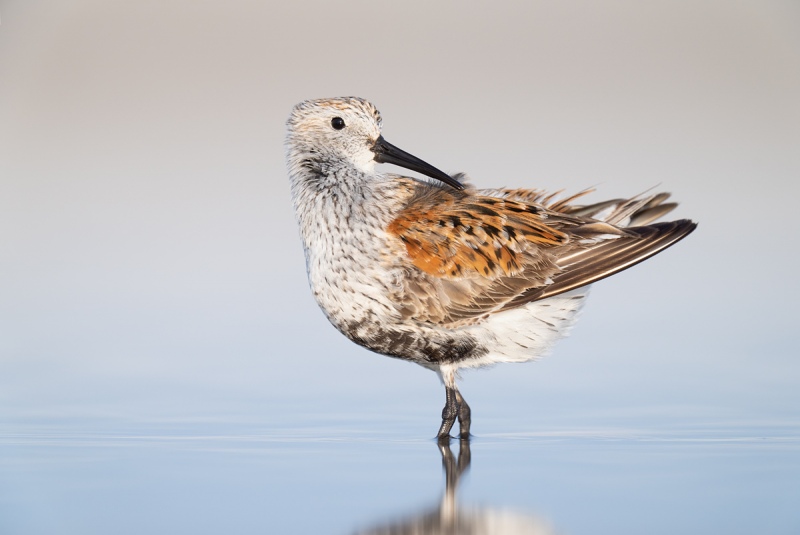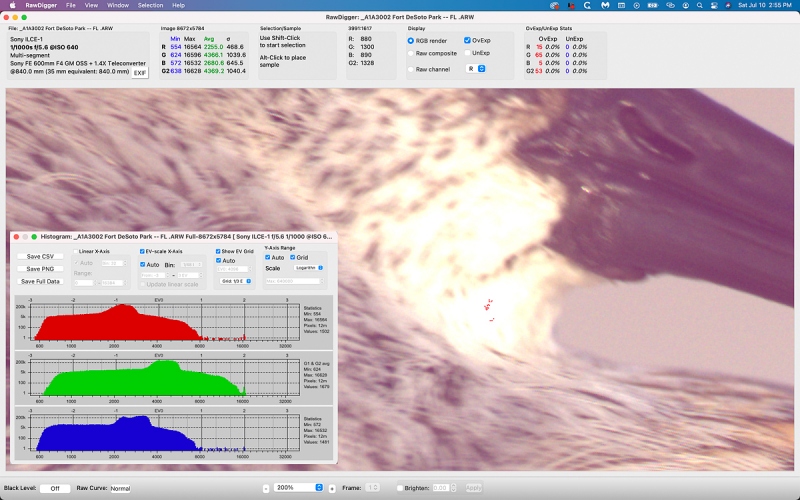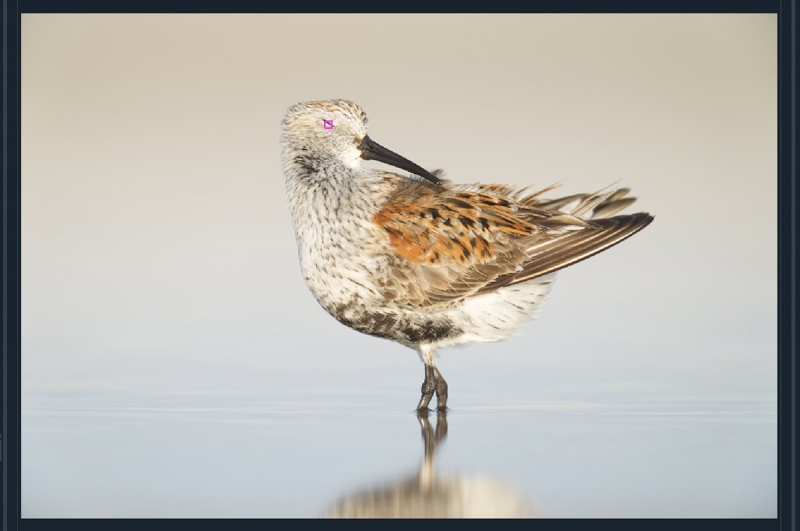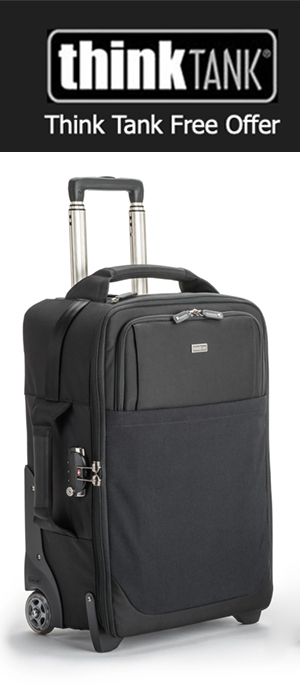What’s Up?
On Saturday morning, I photographed a just-opened Scarlet Hibiscus blossom in our butterfly garden in the backyard. I worked very tight doing the flower center, and came up with a single image that I like.
As I am getting tired of sending out twenty or more e-mails each time that the Sony Alpha a1 Set-up and Info group gets a new member, I decided to create a compilation of all the topics that have been discussed as of 10 July 2021 so that I can send a single PDF. I began yesterday and it will be a lot more work than I had thought. I created and sent the Butt Removal Technique e-mail to the many who commented on the Divide and Conquer Technique Revealed in a Free Excerpt. Clean-up By Popular Demand. And One Bird Butt Too Many blog post here.
Today, Sunday 11 July, is looking like another butterfly garden morning as it is partly cloudy and very still here at ILE just before 7:00am. I will continue working on the a1 compilation and hope to get a bit more work done on my 2020 tax return. Wherever you are, and whatever you are doing, I hope that you too have a great day.
This blog post took about two hours to prepare and makes 196 consecutive days with a new one. Please remember that if an item — a Delkin flash card, or a tripod head — for example, that is available from B&H and/or Bedfords and is also available in the BAA Online Store, it would be great, and greatly appreciated if you would opt to purchase from us. We will match any price. Please remember also to use my B&H affiliate links or to save 3% at Bedfords by using the BIRDSASART discount code at checkout. Doing either often earns you free guides and/or discounts. And doing so always earns my great appreciation.
Please Remember
With income from IPTs now close to zero, please, if you enjoy and learn from the blog, remember to use one of my two affiliate programs when purchasing new gear. Doing so just might make it possible for me to avoid having to try to get a job as a Walmart greeter and will not cost you a single penny more. And if you use Bedfords and remember to enter the BIRDSASART code at checkout, you will save 3% on every order and enjoy free second-day air shipping. In these crazy times — I am out at least forty to sixty thousand dollars so far due to COVID 19 (with lots more to come) — remembering to use my B&H link or to shop at Bedfords will help me out a ton and be greatly appreciated. Overseas folks who cannot order from the US because of import fees, duties, and taxes, are invited to help out by clicking here to leave a blog thank you gift if they see fit.
New and Better Bedfords Discount Policy!
You can now save 3% on all of your Bedfords photo gear purchases by entering the BIRDSASART coupon code at checkout. Your discount will be applied to your pre-tax total. In addition, by using the code you will get 2nd day air shipping via Fed Ex.
Grab a Nikon AF-S Teleconverter TC-14E III and save $14.99. Purchase a Canon EOS R5 and your discount will be $116.97. Purchase a Sony FE 600mm f/4 GM OSS lens and save a remarkable $389.94! Your Bedford’s purchase no longer needs to be greater than $1,000.00 for you to receive a discount. The more you spend, the more you save.
Money Saving Reminder
Many have learned that if you need a hot photo item that is out of stock at B&H and would enjoy free second-day air shipping, your best bet is to click here, place an order with Bedfords, and enter the coupon code BIRDSASART at checkout. If an item is out of stock, contact Steve Elkins via e-mail or on his cell phone at (479) 381-2592 (Central time). Be sure to mention the BIRDSASART coupon code and use it for your online order to save 3% and enjoy free 2nd-day air shipping. Steve has been great at getting folks the hot items that are out of stock at B&H and everywhere else. The wait lists at the big stores can be a year or longer for the hard to get items. Steve will surely get you your gear long before that. For the past year, he has been helping BAA Blog folks get their hands on items like the SONY a9 ii, the SONY 200-600 G OSS lens, the Canon EOS R5, the Canon RF 100-500mm lens, and the Nikon 500mm PF. Steve is personable, helpful, and eager to please.


Gear Questions and Advice
Too many folks attending BAA IPTs (remember those?) and dozens of photographers whom I see in the field and on BPN, are–out of ignorance–using the wrong gear, especially when it comes to tripods and more especially, tripod heads… Please know that I am always glad to answer your gear questions via e-mail
|
|
|
This image was created on 12 May 2021 on a Fort DeSoto IPT. While flat on my belly in wet, sandy mud, I used the Panning Ground Pod-mounted Sony FE 600mm f/4 GM OSS lens with the Sony FE 1.4x Teleconverter and The One, the Sony Alpha 1 Mirrorless digital camera. ISO 640. Exposure determined via Zebras with ISO on the rear dial: 1/1000 sec. at f/5.6 (wide open) in Manual mode. AWB at 7:50am on a mostly sunny morning. Wide AF with Bird-Eye/Face Detection set, performed perfectly as seen in the screen capture below. Image #1: Adult Dunlin molting into breeding plumage — preening after bath |
Anything Major?
Before scrolling down to Image #1B, the AF screen capture that shows the original, enlarge the image above and see if you can find any evidence of major Photoshop work …
An Image Design Multiple Choice Question
With regards to the placement of the bird in the frame:
- a- the bird is perfectly positioned.
- b- the image would be improved if the bird were in the dead center.
- c- the bird is on the wrong side of the frame; it should have been placed on the left side of the photo.
Why I Was Flat On My Belly
With several Dunlin foraging right in front of me, I was working off the rear screen while seated with the lens on the Panning Ground Pod But when two of the birds began preening, I decided to bite the bullet and get down and dirty so that I would have better control of framing and so that I would be able to go vertical if needed. I think that this was the last time that I got down in the mud, preferring now to stay cleaner and drier by sitting and working off the tilted monitor (rear screen) on the back of the camera.
|
|
|
Click on the screen capture to enlarge it so that you can better see the pink OvExp warnings on the bird’s chin. Image #1A: RawDigger screen capture for the Adult Dunlin molting into breeding plumage — preening after bath image |
Dead Solid Perfect Exposure
Note the tiny area of over-exposed pixels on the feathers of the chin denoted by the pink OvExp warnings. With only 133 OvExp pixels out of 51,000,000, this is dead-solid perfect exposure.
RawDigger — not for the faint of heart …
Nothing has ever helped me learn to create perfect exposures to the degree that RawDigger has. I think that many folks are reluctant to learn that most of their images are underexposed by one or more full stops and that highlight warnings in Photoshop, Lightroom, Capture One, and your in-camera histogram are completely bogus as they are based on the embedded JPEGs. Only your raw files tell the truth all the time. Heck, I resisted RawDigger for several years … Once you get over that feeling, RawDigger can become your very best exposure friend no matter what system you are using. On the recent IPTs and In-the-Field sessions, we have demonstrated that fact. Convincingly.
The RawDigger (pink) Adapted Histogram
In the RawDigger e-Guide, you will learn exactly how to set up the Adapted “pink” RawDigger Histogram and how to use it to quickly and easily evaluate the exposure or raw file brightness of images from all digital cameras currently in use. RawDigger was especially helpful to me as I have struggled with R5 exposures and learned my new camera body, the Sony Alpha a1.
|
|
RawDigger e-Guide with Two Videos |
The RawDigger e-Guide with Two Videos
by Arthur Morris with Patrick Sparkman
The RawDigger e-Guide was created only for serious photographers who wish to get the absolute most out of their raw files.
Patrick and I began work on the guide in July 2020. At first we struggled. We asked questions. We learned about Max-G values. We could not figure out why the Max G values varied by camera system. IPT veteran Bart Deamer asked lots of questions that we could not answer. We got help from RawDigger creator Iliah Borg. We learned. In December, Patrick came up with an Adapted Histogram that allows us to evaluate the exposures and raw file brightness for all images created with all digital camera bodies from the last two decades. What we learned each time prompted three complete beginning to end re-writes.
The point of the guide is to teach you to truly expose to the mega-Expose-to-the-Right so that you will minimize noise, maximize image quality, best utilize your camera’s dynamic range, and attain the highest possible level of shadow detail in your RAW files in every situation. In addition, your properly exposed RAW files will contain more tonal information and feature the smoothest possible transitions between tones. And your optimized images will feature rich, accurate color.
We teach you why the GREEN channel is almost always the first to over-expose. We save you money by advising you which version of RawDigger you need. We teach you how to interpret the Max G values for your Canon, Nikon, and SONY camera bodies. It is very likely that the Shock-your-World section will shock you. And lastly — thanks to the technical and practical brilliance of Patrick Sparkman — we teach you a simple way to quickly and easily evaluate your exposures and raw file brightness using an Adapted RawDigger histogram.
The flower video takes you through a session where artie edits a folder of images in Capture One while checking the exposures and Max-G values in RawDigger. The Adapted Histogram video examines a series of recent images with the pink histograms and covers lots of fine points including and especially how to deal with specular highlights. The directions for setting up the Adapted Histogram are in the text.
If we priced this guide based on how much effort we put into it, it would sell it for $999.00. But as this guide will be purchased only by a limited number of serious photographers, we have priced it at $51.00. You can order yours here in the BAA Online Store.
|
|
Image #1B: AF Point screen capture Adult Dunlin molting into breeding plumage — preening after bath image |
Quite Amazing!
Here, the a1’s Bird-Eye/Face Detection AF nailed the bird’s eye even though the eye was completely closed. In the SONY a1 Setup and Info e-mails, I detail the four AF methods that I use, in what situations each performs best, and how to toggle through the four choices almost instantly.
Replacing the Eye
Replacing an eye is relatively simple. I created a Quick Mask of the eye and some surrounding feathers from a very sharp image of the same bird with its eye open. I used the Move Tool to roughly position the eye over the closed eye. Then I reduced the opacity of the layer with the new eye, positioned it perfectly over the squinting eye, and brought the Opacity back up to 100%. Then I added a Regular Layer Mask and painted away some of the surrounding feathers.
|
|
The BIRDS AS ART Current Workflow e-Guide (Digital Basics II).You can order your copy from the BAA Online Store here, by sending a PayPal for $40 here, or by calling Jim or Jennifer weekdays at 863-692-0906 with your credit card in hand. Be sure to specify Digital Basics II. |
The BIRDS AS ART Current Workflow e-Guide (Digital Basics II)
Use of the Photoshop tools and techniques mentioned above for the eye replacement along with dozens of other great Photoshop tips and techniques — along with all of my personalized Keyboard Shortcuts, are covered in detail in the BIRDS AS ART Current Workflow e-Guide (Digital Basics II), an instructional PDF that is sent via e-mail. Learn more and check out the free excerpt in the blog post here. While the new e-Guide reflects my MacBook Pro/Photo Mechanic/DPP 4/Photoshop workflow, folks using a PC and/or BreezeBrowser will also benefit greatly by studying the material on DB II. Note: folks working on a PC and/or those who do not want to miss anything Photoshop may wish to purchase the original Digital Basics along with DB II while saving $15 by clicking here to buy the DB Bundle.
Folks who learn well by following along rather than by reading can check out the complete collection of MP 4 Photoshop Tutorial Videos by clicking here. Note: all of the videos are now priced at an amazingly low $5.00 each.
You can learn how and why I converted all of my Canon digital RAW files in DPP 4 in the DPP 4 RAW Conversion Guide here. More recently, I became proficient at converting my Nikon RAW (NEF) files in Adobe Camera Raw. About two years ago I began converting my Nikon and Sony RAW files in Capture One Pro 12 and continue to do so today.
You can learn advanced Quick Masking and advanced Layer Masking techniques in APTATS I & II. You can save $15 by purchasing the pair.




















As I look at the image, its position is the best of the options. What I would do is crop a bit from the right side. The Dunlin’s head may be turned to the right, but the legs indicate to me that it was moving to the left and will likely continue to do so after it finishes preening. Hence to me, left is the direction of movement in this image.
meant to say that the bird’s head is facing right, so having the bird left of centre that provides that space and “should” work.
The “normal” thing is to have space in the direction the bird is facing so that it has something to “move into”, so for me having the bird left of centre “should” work as that would provide that space. However, the bird, as positioned here is my preference for the reason Mike points out. If the bird was positioned on the left side it would feel like the bird’s head was hitting a wall (depending on how close to the left side it’s placed). All in all, I feel it is perfectly placed.
I like the Adult Dunlin positioned as is. Dead center and aligned left look funny to me.
Thanks for the tip re: switching eyes.
J
Beautiful eye replacement and thanks for telling us how to do it. BTW, I agree with Jeffery, I think the image would be better if the bird was moved to the left of center.
Hi Artie. I normally don’t comment on your photographs, but I do enjoy reviewing them, and I’ve learned a lot from your advice and instructions. Somewhat off the current topic, I must comment on how much I liked the image you presented the other day of the Royal tern being mobbed by the laughing gulls. It was beautiful, one of my favorites. Regarding the current image, the preening dunlin, I think the image would be improved if the bird was moved to to the left of center in the image. Right now I think there is too much dead space to the left of the bird, and that is magnified with the bird looking over its shoulder to the right.
Best regards,
Jeff
Thanks on all counts, Jeff. Every commented is appreciated.
with love, artie
I like the bird’s positioning as shown (it creates the impression that he is moving forward as he looks back), but I find the reflection a little distracting so I might have cropped that out.
Mike